22 Mar Flores Island — Mr Toad Rides Across Flores Island
Peg and I were on Bali when we were overtaken by the urge to see Komodo dragons. You do that by flying to Labuan Bajo on the western end of the island of Flores, then hiring a boat to Komodo.
The man who ran the one-man travel shop told us the flights to Labuan Bajo were filled but not to worry, he’d sell us a ticket to Maumere. “Maumere,” he assured us, “is just two hours from the place where you get a boat Komodo. There’s a travel desk inside the airport terminal where they’ll arrange everything. Hotel. Car. Boat.” That would have been a very good time to have checked a map. Also, it would have been a good time to have asked ourselves why a place as remote as Flores would have two commercial airports within a couple of hour’s drive of each other.
There was a terminal at the Maumere airport, he was right about that . . . if you consider a shed where aircrew can drop off baggage to be a terminal, but the travel desk was an exaggeration. It was a yellowed poster touting things to do in Bali, and there weren’t any travel people at all. Nor were there airline people, or gate attendants, or ticket agents and, after we got through studying the poster, no other passengers, either. They’d all claimed their bags and gone home. It was just me, and Peggy, and a cabdriver. Or, as he styled himself, “guide” . . . because the cab already had a driver. The cab itself was a beat-up private car that didn’t have the word “taxi” anywhere on it. A beat-up old private car.
They were classic Melanesians, just like you read about in anthropology class and, like most Melanesians, wonderfully entrepreneurial. The guide was the guide because he was the one who spoke English. Fifteen words, maybe, but enough to get us into the cab where communicating didn’t turn out to be a problem. Money talks, fistfuls of cash shout and, given the value of Indonesian currency, fistfuls of cash are involved if you so much as purchase a banana. Peg and I weren’t looking to buy bananas. As the guide explained in fluent gesture, we were signing up for a three-day cab ride to the far end of the island. Or, as he up-sold it, a three-day personalized tour.
Flores is a stunningly beautiful island. It doesn’t take long to see why our cousins, Homo florensiensis, the little hobbit-like people who used to live there, chose this out of all the islands in Indonesia. Flores is a gorgeous Eden they shared with pygmy elephants, another species that didn’t quite make it to the present. I would truly love to have seen it then.
We set out toward the west and, around sunset, came to a surprisingly nice lodge on the side of a volcano with three crater lakes on top in three different colors . . . a disconcerting prospect for those of us from a state whose only national park features a volcano with a single crater lake. The next morning we got up before dawn to go see.
A gentleman from Java joined us. He’d set out from Labuan Bajo two days earlier by bus and, when he’d reached the lodge discovered that his luggage had gotten off at a previous stop. Entrepreneurship among Melanesians doesn’t always involve the negotiated exchange of wads of cash.
The five of us headed up the mountain to where the road ended, then hiked another half-hour to an overlook where we could look over into the first crater, the one with the green lake, and saw mists lovelier than water:
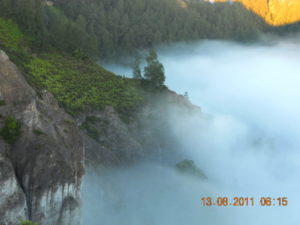
A not-so-green lake
When the mists burned off the lake was as green as advertised, as green as any green from Glidden. In the next crater over, the blue seemed bluer than our own Crater Lake on a sunny day. Off the other way the red lake was a deep, burgundy sort of red. As natural wonders go, these lakes are just about as wonderful as you can get.
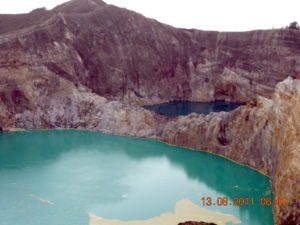
From the lakes we drove down the mountain, then through rice paddies:
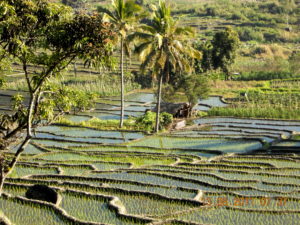
and along black sand beaches

and past volcanoes, a couple of which . . . this being Flores . . . were erupting.

Before dawn on the third day the guide roused us, again. This time, to see a village.
I wasn’t all that eager to see a village. I was sleepy and this waking before dawn was starting to seem intrusive. But, mostly, I was becoming suspicious of the car we were riding in. When the driver wanted to avoid crashing into something he’d yank the handbrake . . . which would have been worrisome enough in flat country, but there’s nothing flat about Flores. The rice paddies might look flat but they’re just low places between very steep ridges. We would creep up a ridge for half-an-hour, then plummet down the far side to the next rice paddy while the driver snatched at the handbrake. Peg had noticed and I had noticed but, since neither of us had noticed the other had noticed, we kept our noticing to ourselves. No point in scaring the person you’re riding with.
We reached the village just after sunup. It was nestled way up on the side of a mountain and the houses weren’t like any we’d seen before, not on Sulawesi, not in Bali, not in Borneo. “Ethnic,” the guide told us. “The village is ethnic.”
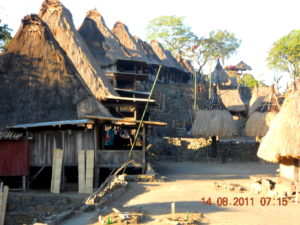
A genuine ethnic village
Back in the car we plunged down the mountain skidding around hairpin switchbacks while the driver rode the handbrake, then past rice paddies and up the next ridge. Traffic heading downhill has the right of way so, very now and then as we worked our way up a ridge we’d have to pull to the side to let a bus or some other large vehicle roar past. This would have been less exciting if the road had come with a shoulder, or a second lane, to pull over to. As it was, our wheels teetered on the edge of oblivion while we stared into rice paddies thousands of feet below.
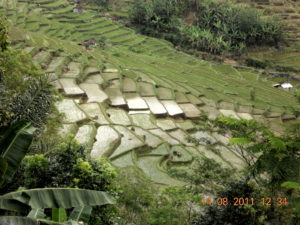
Looking off the side of the road and down
“You know,” it occurred to me when I got a good look, “it’s not actually rice we’re going to land in. It’s jungle.”
“It could be decades,” Peggy said, “before anybody finds us. We should have told somebody we were coming to Flores.”
Bad luck for people looking for evidence of alien abductions: the bus or truck or whatever it was wooshed by, our wheels spun little cascades of gravel into the abyss, the driver pulled back into the middle of the single lane, we crested the ridge, went barreling down the far side and across rice paddies and up another ridge and down until we came to a broad paddy near a little hill with a beautiful bird sitting on a wire. I asked the driver to let us get out and take a picture.
It was a blue-tailed bee-eater and I was just focusing my camera when the guide yelled that he and the driver would be back in a few minutes, and not to worry.
Back in a few minutes? I thought.
Not to worry? Peggy thought. We were automatically worried. Our bags were in the trunk and all we could think about was the gentleman from Java who’d last seen his bags on a bus.
“We’re going to a village to buy something for the car,” the guide waved as they started to pull away.
“Always wanted to see a village,” Peggy and I lunged for the doors.
“You’ve already seen a village,” the guide said as we shoved our way inside. “You should wait here.”
“What,” I asked when we’d closed the doors and they were stuck with us, “are you going to the village for?”
“For?” the guide seemed puzzled by the question.”
“For the car. What do you need to buy for the car?”
“Ah,” he brightened. “For the car. We need a compass.”
“Compass?” That seemed like an odd thing to need on an island that only had one road.
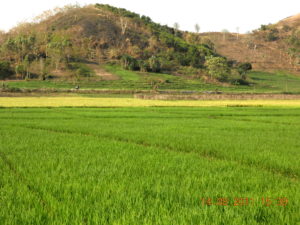
A good place to wait while our ride went looking for a compass
“Compass,” he said again.
After a while we came to a tiny, wooden store and the driver hopped out and came back with a red cardboard box.
“Lemme see that box,” I said.
“Compass,” the guide said and flashed the box at us.
BRAKE PADS the box said.
We roared back the way we came, past the blue-tailed bee-eater, then up the next ridge and over the top and screamed down the other side and across more rice paddies and up and over more ridges and down again while the car filled with the smell of handbrake scorching itself to death. Toward evening we came to a hill overlooking Labuan Bajo.
“You know this town? I asked while we were unloading out bags.
“A little,” the guide said.
“I was wondering if you knew a garage where you can put on the brake pads.”
“Home. We’ll put them on at home.”
“Maumere?”
“If we start now we can be there this time tomorrow.” Night was just beginning to fall.
Maybe they made it, who knows? Or, maybe, some rice farmer will go prospecting through the jungle decades from now and find the crumpled remains of a car, an unopened box of brake pads and skeletal fingers still wrapped around the handbrake.


No Comments